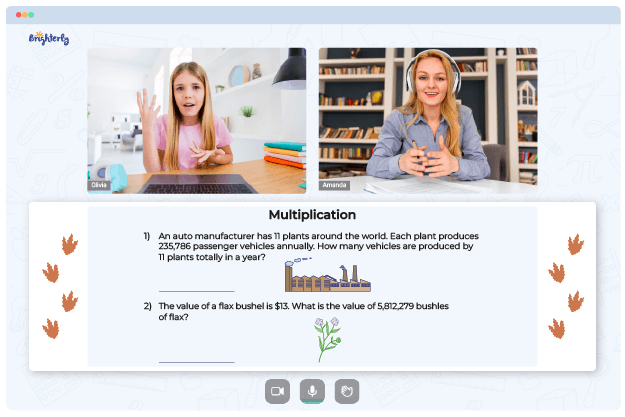Associative Property of Multiplication – Definition With Examples
Created on Jan 15, 2024
Updated on January 15, 2024
Understanding mathematical concepts is crucial for children’s development, and one fundamental concept they encounter is the Associative Property of Multiplication. This property, which forms the foundation of multiplication, allows children to explore how numbers can be grouped and how they relate to addition. In this article, brought to you by Brighterly, we will delve into the definition of the Associative Property of Multiplication and provide engaging examples to enhance comprehension.
What is the Associative Property of Multiplication?
The Associative Property of Multiplication states that when multiplying three or more numbers, the grouping of the numbers does not affect the result. In simpler terms, it means that changing the order in which we multiply a set of numbers doesn’t change the final outcome.
Associative Property of Multiplication Formula
The formula for the Associative Property of Multiplication can be expressed as:
(a * b) * c = a * (b * c)
Here, a, b, and c represent any real numbers that we want to multiply together. This formula demonstrates that regardless of how we group the numbers, the product will remain the same.
Associative Property of Multiplication and Addition
It’s worth noting that the Associative Property of Multiplication is related to the Associative Property of Addition. Both properties involve grouping and changing the order of operations while preserving the final result. These properties are essential in simplifying complex mathematical expressions.
Now, let’s dive into some examples to illustrate the concept more vividly.
Examples on Associative Property of Multiplication
Example 1: Consider the numbers 2, 3, and 4. According to the Associative Property of Multiplication, we can group them in different ways without altering the result:
(2 * 3) * 4 = 6 * 4 = 24
2 * (3 * 4) = 2 * 12 = 24
In both cases, the final product is 24, demonstrating the Associative Property of Multiplication.
Example 2: Let’s take a more complex example: 5, 6, 7, and 8. Applying the Associative Property of Multiplication, we can rearrange the grouping as follows:
((5 * 6) * 7) * 8 = (30 * 7) * 8 = 210 * 8 = 1680
5 * ((6 * 7) * 8) = 5 * (42 * 8) = 5 * 336 = 1680
Again, the result remains the same regardless of the grouping.
Practice Questions on Associative Property of Multiplication
-
Apply the Associative Property of Multiplication to simplify: (3 * 4) * 2 =
-
Demonstrate the Associative Property of Multiplication using the numbers 9, 10, and 11.
-
True or False: The Associative Property of Multiplication can be applied to any set of numbers.
-
Rewrite the expression (2 * 3) * (4 * 5) using the Associative Property of Multiplication.
Conclusion
In conclusion, the Associative Property of Multiplication is a fundamental concept in mathematics that allows children to understand how multiplication can be grouped and how it relates to addition. By grasping this property, children gain a deeper understanding of how numbers interact and how to simplify complex multiplication problems.
Throughout this article, we have explored the definition of the Associative Property of Multiplication and provided numerous examples to reinforce comprehension. By practicing with these examples and understanding the underlying concept, children can strengthen their mathematical skills and problem-solving abilities.
At Brighterly, we believe in making math enjoyable and accessible for children. By introducing concepts like the Associative Property of Multiplication in a creative and engaging manner, we empower children to develop a strong foundation in mathematics. Encouraging children to explore the properties and patterns of numbers will not only enhance their mathematical abilities but also foster critical thinking and analytical skills that will benefit them throughout their lives.
Frequently Asked Questions on the Associative Property of Multiplication
Why is the Associative Property of Multiplication important?
The Associative Property of Multiplication is important because it simplifies calculations and allows us to rearrange the grouping of numbers without affecting the final result. This property is particularly useful when dealing with more complex mathematical operations. By leveraging the Associative Property, we can break down large multiplication problems into smaller, more manageable parts, making calculations faster and more efficient.
Can the Associative Property of Multiplication be applied to any set of numbers?
Yes, the Associative Property of Multiplication holds true for any set of real numbers. Whether we’re multiplying whole numbers, fractions, decimals, or even negative numbers, we can apply the Associative Property to rearrange the grouping without altering the final product. This property is a fundamental rule in mathematics that applies universally, allowing for consistent and reliable calculations across various numerical contexts.
How does the Associative Property of Multiplication relate to the real world?
The Associative Property of Multiplication finds applications in various fields, demonstrating its practical significance in the real world. For instance, in physics, when calculating the force exerted by multiple interacting objects, the ability to regroup the multiplication of factors simplifies the calculations and provides a clearer understanding of the forces at play. In economics, when analyzing the impact of different factors on a product’s price or production costs, the Associative Property allows for efficient evaluation of complex scenarios. In computer science and programming, this property plays a vital role in optimizing algorithms and improving computational efficiency.




